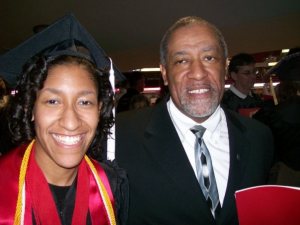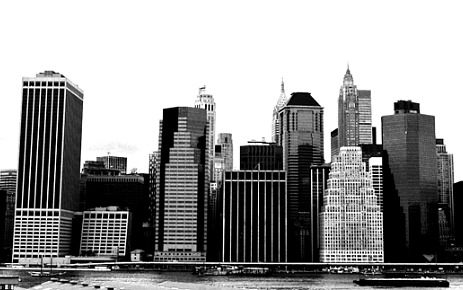 I fell in love with the skyline of Greensboro, N.C., when I was a little kid. I was an urbanist, even if I didn’t yet know such a thing existed.Photo: Jim DollarIt all started with a map on the floor. My dad and I would spend Saturday afternoons “driving” around with my toy NASCARs from my friendly neighborhood Hardees. As I got older, I became enamored of the small skyline of my hometown of Greensboro, N.C. So enamored that one day, while I was sick with the chicken pox, my dad went out and bought me a postcard with the skyline on it. It hangs in my room to this day.
I fell in love with the skyline of Greensboro, N.C., when I was a little kid. I was an urbanist, even if I didn’t yet know such a thing existed.Photo: Jim DollarIt all started with a map on the floor. My dad and I would spend Saturday afternoons “driving” around with my toy NASCARs from my friendly neighborhood Hardees. As I got older, I became enamored of the small skyline of my hometown of Greensboro, N.C. So enamored that one day, while I was sick with the chicken pox, my dad went out and bought me a postcard with the skyline on it. It hangs in my room to this day.
When they widened the main road next to our house, I cried. I also was opposed to a hotel project near my current residence that threatened to upstage the downtown area. Mind you, I was only eight. I was an urbanist in the making, although I would have had no way of knowing there was a name for it.
Dad and I biked through our neighborhood on Saturday afternoons. Those bike rides took us through housing projects and 1940s era single-family homes until we made it to the main suburban artery. I loved my bike until I moved to a neighborhood where I was teased for just walking around. It’s taken me about 15 years to consider getting back on a bike. My dad still bikes; he’s always had a string of intermittently non-working cars, so he doesn’t think twice about it.
I didn’t realize that this behavior and interest had a name — urbanism — until recently. Now, I’m not a hard-core urbanist (Southerners have a natural aversion to paid parking lots and tolls), but still, I’d like to be able to walk around in peace. Bike to a nice full service grocery. Take the bus across town without shame. Get on the train and be in Raleigh in less time than it takes to get down I-40 East.
Problem is, when I look around, I mostly see only one type of person associated with the urbanist label: young, white, and male. Not many young, black, and female, like me. The word “urban,” when it’s associated with African-Americans, is often synonymous with housing projects, poverty, and the poisoned legacy of urban renewal. Over the years, as various government-sponsored and social ills crept into our neighborhoods, our sense of community died.
It shouldn’t be that way. To me, urbanism doesn’t mean just bike lanes and transit-oriented development. It also means people willingly walking to others’ homes to share food and wisdom. It means corner stores and barbershops owned and operated by black community members. Things that were commonplace in the neighborhoods my parents and grandparents speak about.
 My dad and I used to ride bikes together through our neighborhood.Now, I hear the attitudes inside and outside our community — that no one is going to build bike lanes that allow working-class laborers to get to their jobs. That there can’t be a major corporation or major big box store in predominately minority neighborhoods, at least not without raising home prices and driving people out. That working-class neighborhoods can’t exist without crime, and they must only have stores that are run by new immigrants. That natives and immigrants cannot work side-by-side to clean up our beaten-down neighborhoods. And as for that sense of community and ownership? Ha, let’s just wait for the government to help.
My dad and I used to ride bikes together through our neighborhood.Now, I hear the attitudes inside and outside our community — that no one is going to build bike lanes that allow working-class laborers to get to their jobs. That there can’t be a major corporation or major big box store in predominately minority neighborhoods, at least not without raising home prices and driving people out. That working-class neighborhoods can’t exist without crime, and they must only have stores that are run by new immigrants. That natives and immigrants cannot work side-by-side to clean up our beaten-down neighborhoods. And as for that sense of community and ownership? Ha, let’s just wait for the government to help.
I don’t believe that. I believe our community can come back around a collective spirit and embrace the new tools available through new urbanism.
Veronica O. Davis, an urban planner based in southeast D.C., echoes my sentiments. She wrote to me recently:
“I think the key is challenging the perceptions of what is ‘white.’ For example, … east of the [Anacostia] River there are plenty of us that ride bikes. Yet we have no bike infrastructure because ‘bikes are for white people.'”
André Darmanin, a transportation planner based in Edmonton, Alberta, seems to think that the race issue in urbanism is more of an American thing.
“Racial issues and urbanism are more prevalent in the United States than they are in Canada,” he wrote in a message. “Here it’s more a poor person vs. middle income/higher income person [struggle].” He went on to say, “[U]rbanism SHOULDN’T be black or white but with gentrification it happens. What about social justice?”
The black urbanist shares the plight of the black farmer within the black middle-class community — he or she is often perceived as an oxymoron, a contradiction in terms. I could never explain to mom why I was so interested in buildings, unless it might be because I wanted to become an architect. Why preserve the housing projects, many say, when we can move to the far bigger and far cheaper suburbs?
Well, for one thing, the foreclosure, energy, and employment crises have affected African-American communities of all income levels at disproportionate rates. For many black people, the suburban ideal that depends on a big house, a gas-guzzling car, and a high-paying job is moving out of reach and ultimately unsustainable.
Therefore, I hereby propose that we go back to what grandma used to do. Well, my grandma. My MeMe, as we all call her, never met any strangers. Her dinner table never had an empty chair. She embodies that community spirit and respect for culture that I think needs to be a part of the urbanist discourse.
If we all knew each other a little better, we wouldn’t be fighting to take away resources for our neighbors and blaming them for raising our taxes. I send out a special challenge to all of the black churches and mosques that are still prevalent in our communities. Maybe we don’t all agree, but at least let’s take some of our offerings and make sure storefronts are clean and houses are fixed up. Maybe we could help each other keep our houses. Take each other to the store. Start a store.
At the end of the day, I don’t think urbanism needs to be black or white. Maybe I just want to be a gray urbanist. How about you?



